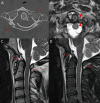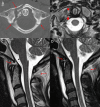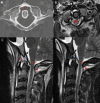Interrelationship Between Craniocervical Dissociation Spectrum Injuries and Atlantoaxial Instability on Trauma Cervical MRI Examinations
- PMID: 36514650
- PMCID: PMC9733797
- DOI: 10.7759/cureus.31238
Interrelationship Between Craniocervical Dissociation Spectrum Injuries and Atlantoaxial Instability on Trauma Cervical MRI Examinations
Abstract
Background and purpose Craniocervical dissociation injuries encompass a spectrum of osteoligamentous injuries between the skull base and C1-C2 that may be treated via prolonged external immobilization versus occipital cervical fusion depending on the risk of persistent craniocervical instability. However, the presence of atlantoaxial instability (AAI) at C1-C2, as determined by transverse atlantal ligament (TAL) integrity with or without a C1 fracture, may guide the neurosurgical management of craniocervical dissociation spectrum injuries (CDSI) since it implies an overall greater degree of instability at the craniocervical junction (CCJ). Materials and methods Adult trauma patients who suffered a transverse atlantal ligament injury on cervical magnetic resonance imaging (MRI) were identified retrospectively. The cervical computed tomography (CT) and magnetic resonance imaging examinations for these patients were reviewed for additional traumatic findings. Demographic information, treatment, and outcome information were recorded. Results Twenty-nine trauma patients presented to the emergency department (ED) with an acute, midsubstance transverse atlantal ligament tear on cervical magnetic resonance imaging. Thirty-one percent of patients demonstrated a tear in at least one major craniocervical ligament (atlanto-occipital capsular ligaments, alar ligaments, and tectorial membrane {TM}) with 14% demonstrating a tear in two major craniocervical ligaments and no patients demonstrating a tear in all three major craniocervical ligaments. Minor craniocervical ligament injuries (anterior atlanto-occipital membrane complex {AAOMc} and posterior atlanto-occipital membrane complex {PAOMc}) were common and observed in 76% of patients. Conclusions Our study suggests that multiple major craniocervical junction ligamentous injuries on cervical magnetic resonance imaging are relatively uncommon in the setting of transverse atlantal ligament injury.
Keywords: atlantoaxial instability; craniocervical dissociation; magnetic resonance imaging; transverse atlantal ligament; trauma.
Copyright © 2022, Fiester et al.
Conflict of interest statement
The authors have declared that no competing interests exist.
Figures




References
-
- The spectrum of traumatic injuries at the craniocervical junction: a review of imaging findings and management. Siddiqui J, Grover PJ, Makalanda HL, Campion T, Bull J, Adams A. Emerg Radiol. 2017;24:377–385. - PubMed
-
- Radiologic spectrum of craniocervical distraction injuries. Deliganis AV, Baxter AB, Hanson JA, Fisher DJ, Cohen WA, Wilson AJ, Mann FA. Radiographics. 2000;20:0–50. - PubMed
-
- The anterior atlantodental ligament: its anatomy and potential functional significance. Tubbs RS, Mortazavi MM, Louis RG, et al. World Neurosurg. 2012;77:775–777. - PubMed
-
- Ligaments of the craniocervical junction. Tubbs RS, Hallock JD, Radcliff V, et al. J Neurosurg Spine. 2011;14:697–709. - PubMed
LinkOut - more resources
Full Text Sources
Miscellaneous
